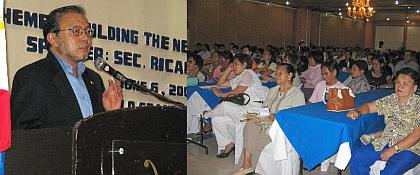Taking wing

6/8/2007 - CABINET Secretary Ricardo Saludo stresses that the New Iloilo Airport of international standard in Cabatuan, Iloilo is one of the 14 airports projects of President Gloria Macapagal Arroyo's Central Philippines Super Region program which is expected to boost tourism industry in this part of the country during a recent multi-sectoral dialogue dubbed "Building the New Philippines" here in Iloilo City. President Arroyo is expected to lead national and local officials during the inauguration of the New Iloilo Airport set on June 13. (PIA 6)
|
OPS 13 March 2007
LAST week at the Presidential Management Staff briefing of the Malacañang Press Corps, we drew the network of RoRo ports that constitute the backbone of our Strong Republic Nautical Highway. Connecting sea lanes and land routes, and building efficient ports for the rapid transit of cargo and passengers, the Nautical Highway has cut travel time from Manila to Mindanao by as much as 10 hours. And transport cost was cut by 40% for passengers and 30% for cargo.
Gains in travel time and savings in transport cost are the most immediate gains to be enjoyed from this infrastructure investment of R23.5 billion, a small dividend from the social payback that Pres. Gloria Macapagal Arroyo is vigorously pushing.
Yesterday, our regular Malacañang Press Corps briefing took wing, in a manner of speaking, as we highlighted 31 priority airport projects being built, improved or rehabilitated, at a cost close of P95 billion.
For the year 2007, an initial eight airports will be completed, costing R15.51 billion, with the Casiguran (Aurora), Kalibo, New Iloilo, and Ozamis airports to be finished during the first semester, and the other four before the year ends. Twenty others will be completed before the end of 2010 and three more by 2011.
At the Diosdado Macapagal International Airport (DMIA), the Radar Approach Control will be finished this month, while the Passenger Terminal expansion project is for completion by December 2007. Passenger traffic at DMIA has increased exponentially since 2003, growing at a dizzying rate of 5,800%, from 7,880 passengers in 2003 to 470,867 by 2006. The DMIA is being developed at a total cost of R57 billion, with full completion targeted in 2011.
Under the New Iloilo Airport Development Project, a 188-hectare site in Cabatuan will replace the one at Manduriao, also in Iloilo City. Built at a cost of R8.7 billion, it generated some 2,600 jobs during construction, with 500 job openings targeted for the airport’s regular operations. Meantime, the existing Iloilo Domestic Airport will be converted into a commercial center. The new airport will be operational next month, in April.
The Kalibo Airport in Aklan, meanwhile, is set to go international this month, with direct flights from Korea set to make their inaugural run. According to Rep. Florencio T. Miraflores of the Lone District of Aklan, who worked for the upgrade of the Kalibo airport to bring it to international rating, some Korean tourists would rather go straight to Boracay, then stopover at Manila.
And speaking of Boracay, the Caticlan airport is now one of the busiest. The area is so busy that a Build Operate Transfer (BOT) airport project on Carabao Island, a short hop from Boracay itself, is being proposed by Boracay Holdings. Business at Boracay must be booming these days, with expanded access via the Nautical Highway and the airports.
As part of the priority infrastructure projects for the Superregions, the airport projects aim to promote the development themes of each of the Superregions. For Central Philippines, 16 airport projects are being improved or constructed as part of the intra-regional and extra-regional transport system that will make the many islands and islets of Central Philippines and its key tourist destinations such as Bicol, Palawan, Bacolod, Iloilo, and Boracay more accessible.
The six airport projects in the North Luzon Agribusiness Quadrangle and the seven in the Mindanao Superregion will contribute to the improvement of the transport of agricultural products as well as provide access to key tourist destinations, while the two airports in the Luzon Urban Beltway, will contribute to the seamless movement of services and people in the industrial and services hubs.
Both as an investment and vital infrastructure, airport development is but one of the strategies of the Arroyo administration to spur economic activity. It is part of the aggressive infrastructure development package that the administration is pursuing, a package that also includes the development of seaports, farm-to-market roads, among others.
On the back of these infrastructure development projects rest the ambitious development targets of the administration, to attain a gross domestic product (GDP) growth rate of 7% in 2007, 8% in 2008 and 9% by 2009, under the 789 economic development plan.
On the very short term, the President sees the completion of some of these infrastructure projects resulting in greater investments, even as it gives further impetus to the President’s 8 by ‘08 agenda, which includes the generation of more jobs, the lowering of the cost of living, the further strengthening of the peso, implementation of more pro-poor programs, in the areas of education, healthcare, housing and food, the Green Philippines and a country made more secure against the threat of terrorist assaults.
These goals are within reach in time. More to the point, these are goals that can be achieved faster with the cooperation of all sectors.
Once cooperation and unity are in place, it may be safe to say that the "ship of state" has taken wing, and is well on its way towards its destination of becoming a first world country by 2020.
|
